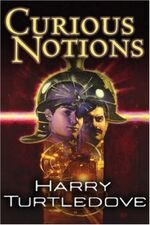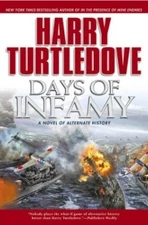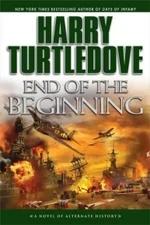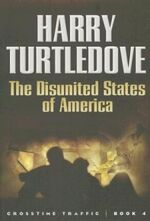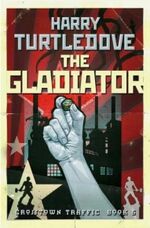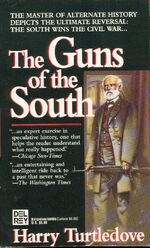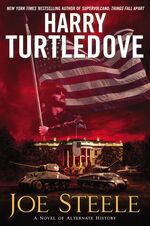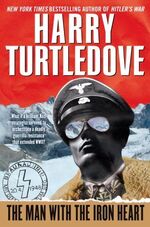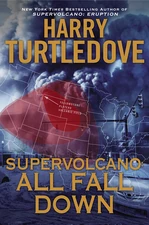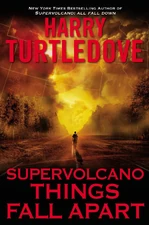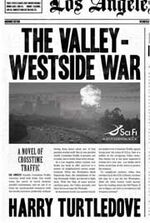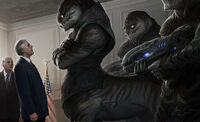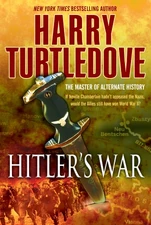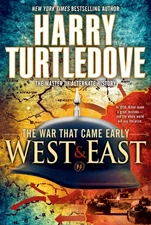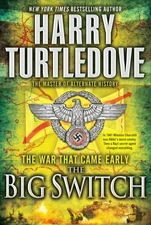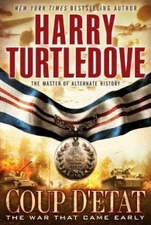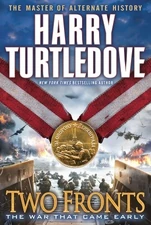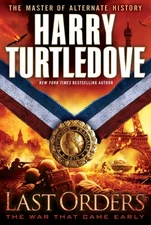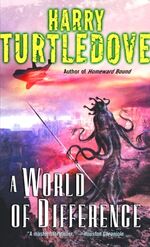For the equivalent of the United States in A Different Flesh, Southern Victory, The Two Georges, and Worldwar, see Federated Commonwealths of America, United States of America (Southern Victory), North American Union, and United States of America (Worldwar), respectively.
| United States of America | |
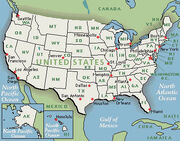
| |

| |
| Country | |
| Continent: | North America |
| Capital: | Washington, DC |
| National Language: | none |
| Government: | Presidential Federal Republic |
| Status in OTL: | Active |
The United States of America (also known as the United States, the U.S., the USA, the States, and America) is a federal constitutional republic comprising 50 states and a federal district. Its capital is Washington in that federal district.
The nation was founded by 13 colonies of Britain located along the Atlantic seaboard of North America. On July 4, 1776, they issued the Declaration of Independence, which proclaimed their independence from Great Britain and their formation of a cooperative union. The rebellious states defeated Great Britain in the American Revolutionary War, the first successful colonial war of independence. A federal convention adopted the current United States Constitution on September 17, 1787; its ratification the following year made the states part of a single republic with a strong central government. The Bill of Rights, comprising ten constitutional amendments guaranteeing many fundamental civil rights and freedoms, was ratified in 1791.
In the 19th century, the United States acquired land from France, Spain, the United Kingdom, Mexico, and Russia, and annexed the Republic of Texas and the Republic of Hawaii. Disputes between the agrarian South and industrial North over states' rights and the expansion of the institution of slavery provoked the American Civil War of the 1860s. The North's victory prevented a permanent split of the country and led to the end of legal slavery in the United States. By the 1870s, the national economy was the world's largest. The Spanish–American War and World War I confirmed the country's status as a military power. In 1945, the United States emerged from World War II as the first country with nuclear weapons, a permanent member of the United Nations Security Council, and a founding member of NATO. The end of the Cold War left the United States as the sole superpower.
Literary comment
In some Harry Turtledove timelines with a POD before 1776, the United States is supplanted by a different but similar country. In some with a later POD, the Union's altered history is broad and complex enough to merit its own article for that timeline. See the top of this page for a list.
United States in The Case of the Toxic Spell Dump
The Confederated Provinces, or the Confederation for short, was a large nation in North America. The District of St. Columba was its capital. After winning independence from Great Britain in the 18th century, the Confederation conquered prize lands from the Empire of Aztecia in the 1840s.
United States in Crosstime Traffic
Crosstime Traffic maintained a base of operations in the United States in the home timeline. The United States was suspected of having destroyed the Syrian capital Damascus in 2033 with a nuclear weapon smuggled into the city. In the mid 21st Century, the US and the European Union intervened in Iran. However, the Second Iranian Intervention did not go as planned.[1]
The company was aware of several alternates with differing versions of the US. There were several where the Confederate States had won the American Civil War and others where the United States had been conquered by the Axis.[2] There was at least one where the United States had become a dictatorship and went on to dominate the world.[3] In another alternate, the United States never existed as the American Revolution did not take place.
In an alternate where nuclear weapons had never been developed, the United States and the Soviet Union fought World War VI in the 2090s. Footage taken in this alternate was shown to Jeremy Solters and his fellow students in US history class.[4] Conversely, there were several alternates where an atomic war took place in the 20th Century. Explorers from the home timeline found that in some of these alternates the USSR had started the war whereas in others, the US had fired the first shots.[5] Some of these were in the process of getting back on their feet. Others were completely devoid of human life.
United States in Curious Notions
In the alternate designated as 3477 by Crosstime Traffic, the United States remained neutral during the war of 1914, and watched helplessly as Germany subdued Europe, solidifying its rule by the late 1930s. In 1956, Germany attacked and defeated the United States, dropping atomic bombs on a dozen cities on the first day of its war. The United States remained under German rule over 140 years later.
United States in The Disunited States of America
The United States was the name of a nation which existed for about 30 years in the late 18th and early 19th centuries. The nation's doom was sealed in 1787, when a conflict at the Constitutional Convention over the nature of representation could not be resolved or compromised. A new Constitution was never adopted, so the weak Articles of Confederation were allowed to stand, the central government never managed to control the states, and eventually all of the states became independent countries.
United States in The Gladiator
The United States backed down during the Cuban Missile Crisis in 1962, allowing the Soviet Union to maintain missiles in Cuba. This decision signaled to the world that the United States was not as ardent about fighting the Cold War as it claimed. In 1968, the U.S. withdrew troops from the Vietnam War. In response, European communists and socialists established popular fronts, which gradually pushed European governments away from the US and towards the Soviet Union. By the 1970s, most of Europe was under communist rule.
The United States held out on its own until the end of the 20th century, when it too fell to communist rule. By the late 21st century, the United States was seen as harmless, and was completely obedient to the USSR.
Americans were usually portrayed as villains in the popular culture of the world, often acting as spies who sought to bring back capitalism or Nazism or both.
The Crosstime Traffic employee Eduardo Caruso considered this alternate to be only slightly better than ones in which Fascism had come to dominate the world.[6]
United States in The Valley-Westside War
Following its devastating nuclear war with the Soviet Union in 1967, the territory of the United States was split up into countless mini-states and chaotic lawless areas. Just in the former city of Los Angeles there were several such states, jealous of their full sovereignty and occasionally going to war with each other. In most ways, people felt loyalty to their own state and regarded the inhabitants of other states carved from former US territory as "foreigners" and often as outright enemies. Still, many of these states continued celebrating the Fourth of July, expressing a vestigial feeling of being "Americans" and a remaining hostility towards the Russians, though most people had no real idea of where Russia was or what "communism" was. There was also a hope that sooner or later the whole territory of the United States would be reunited, though nobody could guess when and how that would be effected. People in The Valley expressed the hope that one day a descendant of King Zev might achieve this task, but they had no real concept of how big the United States had been, having only a vague idea even about distant parts of what had been the State of California.
United States in Days of Infamy
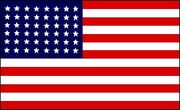
The United States had sought to remain neutral in the conflict that was quickly evolving into World War II. That ended in 1941, when, in response to Japan's aggression in China, the United States stopped selling oil and steel to Japan. Japan saw this as an act of aggression, as without these resources Japan's military machine would grind to a halt. In March, 1941, the Japanese government resolved to go to war with the United States. The first blow would be an attack on the U.S. naval base at Pearl Harbor, on the U.S. territory of Hawaii. However, at the insistence of Commander Minoru Genda and Admiral Isoroku Yamamoto, that plan became an invasion of Hawaii.
The invasion began on December 7, 1941. U.S. forces, believing such an attack impossible while also presuming their inherent superiority, were surprised by the efficiency and skill Japanese forces demonstrated. The Japanese quickly gained dominance of the air and the sea, and U.S. ground forces were overwhelmed by the tenacity of the Japanese army. By February, 1942, U.S. forces surrendered.
For the remainder of 1942, U.S. policy was directed to regaining Hawaii, while also at war with Japan's ally, Germany. President Franklin D. Roosevelt wanted to pursue a "Germany first" policy in the war, but the loss of Hawaii, followed by Japan's air raid on San Francisco, forced the U.S. to focus its attention on the Pacific.
The first response from the U.S. came in March 1942, when Jimmy Doolittle led an air-raid on Oahu. In retaliation, Japanese bombers raided San Francisco, an act that further humiliated the U.S.
In June, 1942, the United States sent a fleet of three aircraft carriers and assorted troopships and destroyers to retake the islands. The Japanese navy met the Americans, sinking two of the carriers (the Saratoga and the Yorktown) and forcing a retreat. Embarrassed, the United States continued its production of aircraft carriers. It was able to hurt Japan's supply lines via submarines and harassed the islands with bombing raids.
In the wake of the failed invasion, the U.S. concentrated on a realistic plan for invading Hawaii, assembling an overwhelming force. In 1943, the United States returned, with a massive fleet, comprised of some seven aircraft carriers, five light carriers, close to a dozen escort carriers, several destroyers, and troop carriers. This invasion proved to be the end of Japanese rule in Hawaii, as the Japanese naval contingent was destroyed, and the Japanese supply line, already taxed, was broken completely. American forces landed at Oahu, and after a period of bitter fighting, were able to subdue Japan's ground forces.
The United States turned its attention to Midway, which was still under Japanese control.
United States in "Elder Skelter"
The United States was in the throws of a generational crisis as Boomers retained the reigns of government in the face of Generation Xers and Wires. The Twenty-Eighth Amendment to the Constitution had been passed, which called for a balanced budget and restrained entitlement programs.
When Quebec invaded the Maritimes, the Maritimes called on the US to arbitrate a cease-fire and send peace-keepers. In a cabinet meeting, the president reazlied that the Twenty-Eighth Amendment limited her use of peace-keepers. She was also confronted by the generational anxiety of her younger cabinet members. The situation was made more difficult by the possibility that Quebec might next turn its attention to Maine if it wasn't stopped in the Maritimes.
United States in "Getting Real"
Early in the 21st century China refused to continue to lend to the United States causing a severe economic downturn. The debts resulted in the U.S. ceding Catalina Island and the rest of the California Channel Islands to China. The U.S. reacted poorly causing its problems to escalate so that by 2117 it was considered by the world an "economic basket case".
During this period, the U.S. government and its citizens refused to recognize their changed status and continued to act as though it were the premier superpower leading to further declines. China used this to its advantage and gained the U.S.'s former status. The U.S. also reacted militarily but had lost ground technologically as well so that its attacks were defeated. The resulting indemnities required the United States to lease Long Beach and San Pedro to the Chinese while Los Angles was temporally put under military occupation by the Chinese. These actions insured that the U.S. would continue its decline.
United States in The Guns of the South
In 1861, under President Abraham Lincoln, the United States became involved in a civil war when eleven slaveholding Southern states opted to secede from the Union and form the Confederate States of America. Four years of warfare (what became known as the Second American Revolution) followed.
In 1864, the Confederacy's chances of victory were diminishing in the face several critical military defeats and the vast difference in industrial and human resources that favored the U.S. However, through the actions of a group of time-traveling members of the Afrikaner Weerstandsbeweging, a racist South African organization, the South was saved. The Rivington Men (as they came to be called) supplied Robert E. Lee's Army of Northern Virginia with AK-47 automatic rifles. These futuristic weapons more than made up for the Confederacy's lack of resources.
After several weeks of training, the Army of Northern Virginia engaged the Federal military at the Wilderness and then Bealeton, Virginia. The Federals were completely surprised by the new "repeaters", and quickly collapsed. In a news paper article of the time in the short battles in the Wilderness the federals suffered 40,000 losses. The ANV pressed on to Washington City, where President Abraham Lincoln had remained despite the encroaching enemy. When Lee and his army arrived, Lincoln invited the rebel commander into the White House to negotiate an armistice, ending major combat of the Second American Revolution.
The United States licked its wounds. Lincoln was voted out of office, although he was able to secure reasonably good terms for peace. One conflict was the status of Kentucky and Missouri, two slave-states. Under a compromise, both were allowed to decide which country they would join in a plebiscite. Missouri remained part of the United States, while Kentucky joined the Confederate States.
The United States was able reverse engineer AK-47s captured from Confederate troops. These guns were put into mass production. Although not quite as reliable as the Confederate models, the guns were nonetheless successful. By 1867, the United States had launched a war with Britain and an invasion of Canada.
United States in The Hot War
The United States, under the leadership of President Harry Truman, made a series of political miscalculations over the Korean War helped spark World War III.
In November 1950, Chinese troops intervened in the Korean War and thoroughly destroyed three divisions of American forces between the Chosin Reservoir and Hungnam, the worst defeat American forces had seen since the Battle of Bataan during World War II.[7]
Truman flew to Honolulu on December 18, 1950 to meet with General Douglas MacArthur, the overall commander in the Pacific. While MacArthur didn't quite admit he'd been wrong when he assured Truman that the Chinese would not intervene, he did acknowledge that they were attacking and would continue to mass along the Yalu River until China itself was attacked. When Truman pointed out that B-29s weren't doing as well during this was as they had during World War II, MacArthur suggested atomic weapons might make the difference if they were used on cities in Manchuria to disrupt the Chinese supply line.
Truman then wondered if Joseph Stalin and the Soviet Union would retaliate against U.S. allies should the U.S. bomb Manchuria. MacArthur dismissed these concerns, arguing that the USSR did not have sufficient atomic weapons to do so. He also argued that U.S. atomic weapons could be used in the case of a Soviet invasion of West Germany. Despite his misgivings, Truman agreed to the use of atomic weapons. Truman admitted that if the three divisions in North Korea has been successfully evacuated from Hungnam, he would not have considered the atomic option.[8]
In January 1951, pits were delivered to Korea and installed in all weapons already present.[9] A few weeks later, Truman transferred the final decision making to MacArthur, authorizing the general to use them if, in MacArthur's view, their use was the only way to improve the situation. The situation had certainly worsened, as the Chinese had relentlessly marched south throughout December and into January, recapturing Seoul, the South Korean capital.[10] In the meantime, U.S. aerial reconnaissance showed that the Soviets were moving fighters and bombers onto airstrips in southeastern Siberia.[11]
The decision finally came a few weeks later. On January 23, 1951, several bombs were dropped on strategic points in Manchuria.[12] Within hours, Truman appeared before the country explaining the action and his reasons for approving it. He also emphasized that Soviet territory had not been attacked.[13] Despite his assurances that the US had no quarrel with the USSR, Joseph Stalin retaliated on behalf of his ally, China, and ordered six atomic attacks against U.S. allies staged from Pechenga[14]: Aberdeen and Norwich in the United Kingdom; Nancy and Rouen in France, and; Augsburg and Bremen in West Germany.[15] The Soviet army headed west as the bombs were landing in Europe, as did the armies of its various satellites.[16]
The attacks on Britain and France effectively triggered the NATO treaty. British Prime Minister Clement Attlee and French President Vincent Auriol immediately demanded the U.S. respond. So did West Germany, but as that country wasn't in NATO, Truman felt comfortable ignoring them.[17] Truman consulted with Secretary of Defense George Marshall. While neither were enthusiastic about attacking the Soviets again, Truman decided that destroying Pechenga was the least terrible option, as it might mollify Britain and France, and was sufficiently isolated from more populous Soviet territory that Stalin might not feel compelled to respond. Ignoring the European attacks might end NATO altogether and send Europe into an alliance with Stalin. At Marshall's suggestion, Truman had the planes fly out of the UK and France. He also ordered Alaska put on alert, as it was similar to Pechenga, and would be a likely target if Stalin did retaliate.[18]
Pechenga was destroyed on February 4, 1951. Despite Truman's order for precautions, Elmendorf Air Force Base was destroyed by the Soviets on February 7.[19]
In response, on February 15, Truman authorized atomic attacks against Russia's satellites, destroying Zywiec in Poland, Szekesfehervar in Hungary, and Ceske Budejovice in Czechoslovakia in an effort to disrupt several transportation hubs.[20] Two days later, the Soviet invasion of West Germany began, and World War III was now past the point of no return.[21]
The Soviets, using their numerical superiority, made substantial gains in West Germany, Austria and northeastern Italy, despite huge casualties inflicted on them by Allied forces.[22] In response, on February 24, U.S. launching bombing raids against various targets within the USSR and its allied countries, including Warsaw and Krakow in Poland, Prague and Bratislava in Czechoslovakia, and Budapest in Hungary, and the Soviet cities of Leningrad and Vladivostok, as well as Minsk in Byelorussian SSR and Rovno in the Ukranian SSR. Allegedly, the Leningrad attack (a night raid) killed several children playing in a park for which Stalin promised retribution.[23]
As February wound down, the U.S. was faced with what he termed as a catastrophe. He realized that the U.S. probably didn't have the manpower to stop the Russians, even with Britain and France contributing. Truman was already regretting the decision to bomb Manchuria, especially as the only solution he and Secretary of Defense Marshall could see to remedy the disparity in manpower was the use of more atom bombs.[24] However, as West German Chancellor Konrad Adenauer had wired Truman and begged him not to use atom bombs in West German territory, lest the U.S. lose West Germany as an ally, Truman ruled it out, despite Marshall's misgivings. Instead, Truman decided to use bombs in East Germany and in Russia's satellites with the goal of slowing down the Soviet supply line. He even hoped that the attacks might prompt the governments of the various satellites to reconsider their alliance with Russia, or to prompt the citizens of those states to rebel against their communist governments.[25] Truman further decided not to attack capital cities, but instead smaller towns that had important rail lines. Marshall prepared a list for Truman's approval.[26]
While the atomic attacks did disrupt Soviet supply lines and slow down the drive west, they did not cause any uprisings.[27] They also resulted in the most audacious attacks from the Soviets to date. On the night of March 1-2, Soviet Tu-4s, painted to look like the American B-29s they'd been reverse engineered from, dropped several atomic bombs on the American west, including the cities of Seattle, Portland, Los Angeles, San Francisco, Salt Lake City and Denver.[28] On the East Coast, Bangor in Maine and Newfoundland in Canada were also attacked.[29] On the plus side, bombers mean for Spokane and Las Vegas were successfully downed.[30]
In response, Truman ordered massive retaliation that destroyed a number of Soviet ports on March 4, including Vladivostok[31] (a successful if costly attack for the U.S.), as well as Kiev,[32]. In the following weeks, the U.S. also dropped atomic bombs on Leningrad[33] and Moscow itself.[34] Stalin survived this attack, and took to the radio to rally the Soviet Union.[35]
In April, Truman finally took a tour of the West Coast. He gave a candid press conference in Los Angeles, where he'd come to see the damage. He allowed his administration had made several mistakes in its handling of the war, but that the country would press on.[36] In the immediate aftermath of the bombings, the National Guard was called out in the impacted states to maintain order,[37] and established refugee camps for the displaced.[38] Over the next couple of months, the National Guard set up border checkpoints in Washington, Oregon, and California.[39]
A few days after the West Coast trip, the Soviet Union attacked several airfields in the U.K. with conventional explosives, including USAF barracks at Sculthorpe. While the attacks killed several and did a fair amount of damage, compared with an atomic bomb, the attacks were more nuisances.[40] However, days later, the Soviets inflicted another atomic attack on the U.S. when it successfully placed an atom bomb in a Greek-listed freighter, and successfully detonated the bomb in the Panama Canal near the Caribbean end; if the canal were repairable at all, it would be years. The Soviets also destroyed the Suez Canal.[41]
In May, the U.S. was able to destroy Khabarovsk and Blagoveshchensk, two key Soviet cities on the Trans-Siberian railroad; the attacks were designed to hamper Soviet aid to its allies in Korea.[42] Nonetheless, Truman was subject to increasingly sharp criticism at home. His loudest critic was Senator Joseph McCarthy, who claimed that Truman and Secretary Marshall were soft on Communism, and alleged the "Reds" uncovered in the State Department during Marshall's tenure there had shared the USA's weaknesses with the Soviets before they were caught.[43]
In June, the Soviets successfully bombed on Paris,[44] effectively wiping out the French government. Several surviving officials established a Committee of National Salvation, and asked Charles de Gaulle to become its head.[45] De Gaulle's first task was to contact Truman for aid, including medical supplies and experts in treating radiation sickness. While de Gaulle and Truman had shared a deep antipathy from the closing days of World War II, Truman realized that de Gaulle could forge a separate peace with the USSR, and so did everything he could to meet de Gaulle's requests.[46]
By July 1951, the situation in Europe was critical: Soviet forces had crossed most of West Germany and were approaching the borders with the Netherlands and Luxembourg, and held the Po Valley in Italy. Truman had little hope they'd keep fighting if the Russians continued their advances.[47] Thus, in order to halt the advance, and keep the Western Allies in the fight, Truman ordered the use of atom bombs on the Soviet forward positions in West Germany.[48]
The attacks destroyed most of the Soviet forward positions, forcing the survivors to retreat back east.[49] Afterward, Truman gave a press conference, and once again offered Joseph Stalin the status quo ante bellum, with all communist forces in Europe and Korea pulling back to their pre-war borders. Stalin refused.[50]
On the home front, things began to stabilize, even in areas that had been attacked. Traces of normality returned in fits and starts to places like Glendale.[51] Places that had not been targeted also carried on as if there wasn't a war on at all.[52] And soon, McCarthy was not the only person seeking the Republican nomination: Senator Robert Taft, California Governor Earl Warren, and General Dwight Eisenhower had thrown their hats in the ring.[53] While the Allies were advancing for the first time since the beginning of the ground war, Stalin still had a sufficient atomic arsenal to respond. In short order, the Soviets attacked targets in South Korea in August,[54] and then destroyed the U.S. airbase in Sculthorpe, U.K. in September.[55] Worst of all was the attack on Antwerp, Belgium a few weeks later.[56]
Truman was forced to concede to the Prime Ministers of Belgium and the Netherlands the U.S. could not promise to protect them from Soviet attacks.[57] When Truman met with Secretary of Defense Marshall afterward, Marshall acknowledged that Truman had told the premiers the truth. He assured Truman that the Soviets could not reach the U.S. East Coast at this time.[58]
After several more weeks of weighing his chances for re-election, in October 1951, Truman announced that he would not be running again in 1952.[59] Predictably, Soviet propaganda declared Truman a coward.[60] Now the field for the Democratic Party was wide open, and several candidates announced their own bids, including Vice President Alben Barkley, Illinois Governor Adlai Stevenson, Truman-aid W. Averell Harriman, and Senators Hubert Humphrey of Minnesota and Estes Kefauver of Tennessee.[61] While each man had his strengths and weaknesses, by spring of 1952, there wasn't a clear Democratic front-runner the way McCarthy had become for the GOP.
In May 1952, even as the NATO drive continued east and the Soviet Union's resources were being drained, the Soviets launched an air raid on the East Coast of the U.S. After months of practice, Soviet Tu-4s were able to cross the Atlantic using mid-air refueling.[62] Washington DC, New York City, and Boston were all destroyed. President Truman was attending a fund-raiser in Buffalo, New York, and thus survived an attack that effectively wiped out the U.S Federal government, his wife and daughter included..[63]
Philadelphia became the acting capital of the U.S.; it had also been targeted, but spared when the Tu-4 assigned to attack the city crashed in New Egypt, New Jersey.[64] Truman spoke to Chief Justice Fred Vinson--seven of the nine Supreme Court Justices had been in St. Louis. Vinson concluded that Truman would have broad emergency powers while the U.S. rebuilt its government. Truman also promised final vengeance on Stalin.[65] The immediate U.S. response was to destroy Murmansk, Arkhangelsk and Odessa.[66]
United States in In the Presence of Mine Enemies
The United States remained neutral during the Second World War, watching as country after country fell in Europe and in Asia. After the war, the United States found itself in a growing cold war with the victorious Axis, particularly the Germany and the Empire of Japan, climaxing with the Third World War in the late 1960s. Germany was the first country to develop nuclear weapons, destroying Washington, DC and Philadelphia during the fighting. While the U.S. was able to counter-attack German soil, it was subdued by its enemies. During the war, America lost a third of its population.
After the war ended, the Reich genocided the Jewish and Negro populations in the United States with large massacres taking place in New York City and Los Angeles. Segments of the white American population assisted in these massacres.
With Washington, DC reduced to a nuclear wasteland, the American capital was moved to Omaha in the Mid West where a pro-Nazi American administration was established. The US paid an annual tribute, which became an important source of income for the Reich's economy. When the United States was either unable to pay this tribute or was late in doing so, the Wehrmacht, which maintained bases in New York, Chicago, St. Louis and Omaha itself, used terror tactics to bring the U.S. in line.
The American economy underwent hyperinflation following the war with the US Dollar fallen from its place as a major world currency.
In 2010, as part of the reforms promised by the fourth Führer Heinz Buckliger, Germany reduced the annual assessment by 13% (allowing the American economy to flow easier) and sent a division of occupation troops in the US back to the Reich (allowing the Americans to do more as they pleased with a lesser chance of being bullied and harassed by the occupation troops). Despite this, some Oberkommando der Wehrmacht officials like Heinrich Gimpel and Willi Dorsch assumed that the Americans would always try to find ways out of paying the annual tribute.
In 2011, the U.S. effectively defaulted. However, the Reich did not respond militarily as it had in the past. Nonetheless, the Wehrmacht was keen to keep the U.S. under heel, knowing full well that the U.S. could make a formidable opponent if it regained its freedom.
United States in Joe Steele
The United States' history of representative government came to an end upon the 1932 election of California Congressman Joe Steele to the Presidency.
In 1932, the country was still suffering the affects of the Great Depression, and had grown disenchanted with incumbent Republican President Herbert Hoover. The Democratic Party saw its opportunity, with Steele and New York governor Franklin D. Roosevelt became the front runners for the party's presidential nomination. Steele touted his Four Year Plan, which included collectivizing farms, updating the country's power grid, and nationalizing the banks. Roosevelt pledged his New Deal plan.[67]
When the Convention vote started to turn Roosevelt's way, Steele arranged to have Roosevelt burned alive at Executive Mansion in Albany.[68][69] With his primary opponent gone, Steele became the party's presidential nominee.[70] His running mate was John Nance Garner, with whom Steele had reached an early arrangement.[71] Through his vigorous campaigning, populist appeal and his relatively concrete Four Year Plan, Steele handily defeated Herbert Hoover.[72]
From his inauguration, Steele put his Four Year Plan into action. While he wasn't a particularly dynamic speaker, he did speak with confidence. During his inaugural address as president on March 4, 1933, he emphasized his humble beginnings, his status as a self-made man, and promised that the American people would have jobs in his Four Year Plan. Moreover, he promised that he would be "rough and harsh" toward those who were "harming" the United States. He concluded with one last populist promise to nationalize the country's banks, which was met with thunderous applause.[73]
Steele didn't waste time, calling a special session of Congress, and introduced legislation that nationalized the banks. When he was met with opposition from conservative members of Congress, Steele reached out to young-and-coming Bureau of Investigation chief J. Edgar Hoover to investigate opponents of the nationalization scheme. Hoover "found out" that Senator Carter Glass, the leader of the opposition, had a secret love child with his family's Negro maid in his youth.[74] When Steele shared this information with Glass, Glass caved and changed his vote. Soon enough, the remaining opponents fell in line.[75]
With the nationalization complete, Steele continued proposing legislation to regulate the country's financial institutions and labor unions. Moreover, after his willingness to blackmail his opponents during the nationalization fight, the bills Steele proposed sailed through Congress. He also instituted make-work projects and proposed community farms in the Midwest. While some critics suggested Steele's community farms were identical to the farms in the Soviet Union, Steele responded by telling the people: "If you want to see food on the table and men proud of what they do, let your Senators and Representatives know about it." The farm bill passed.[76] The various comparisons of Steele's policies to the Soviet Union's were ironic, as Steele was quite vocal in his hatred for Leon Trotsky. Indeed, the US did not recognize the Soviet government until the outbreak of World War II.[77]
In mid-1933, Steele proposed legislation for electrifying the Tennessee Valley, the last piece of legislation in the special session. He went on radio to ask the American people tell their Senators and Representatives to support the bill. The Administration also took the liberty of composing letters, claiming to be from citizens, and sending them to Congress.[78]
However, the federal judiciary began overturning the legislation on appeal, and soon, most of the Four Year Plan was before the Supreme Court, which systematically began ruling the legislation unconstitutional.[79] In response, Steele ordered J. Edgar Hoover to investigate the court.[80] Then Steele gave a radio speech in which he denounced the Supreme Court as nine old men who were not elected, and who were actively wrecking the country. Steele implied the Court's actions were deliberate, and promised that there would be an investigation.[81]
Hoover discovered "evidence" that four justices - James McReynolds, Pierce Butler, Willis Van Devanter, and George Sutherland - who were also the most consistent in ruling the Four Year Plan unconstitutional - were in fact colluding with foreign powers against the United States. In February 1934, Hoover led a group of agents to very publicly arrest the Supreme Court Four for treason while they were in the middle of deliberations.[82]
Steele then took the additional step of suspending the writ of habeas corpus, much to the astonishment and horror of many. Steele argued that, while the country was not in a rebellion or at war with another country, it was at war with hunger, want, and poverty.[83]
In September 1934, the Supreme Court Four were tried by a military tribunal. The Four confessed to colluding with Nazi Germany, and were sentenced to death by the tribunal. Furthermore, the Four identified Louisiana Senator Huey Long and radio personality Father Coughlin as being part of their "conspiracy".[84] While their attorneys did appeal to the remaining Supreme Court and Steele himself, Steele refused to grant clemency, and the Four were promptly executed.[85]
Coughlin was taken into custody, but Long immediately returned to Baton Rouge ahead of an arrest, and began railing against Steele's new "War of Northern Aggression". Long's hold on the state was such that even Federal officers kowtowed to him.[86] Steele's calm response was that the laws of the country had to be obeyed, and that Long should taken into custody.[87] The issue was rendered moot when Long was shot through the head by a sniper while speaking in front of City Hall while giving a speech in Alexandria. His bodyguards responded in a confused manner, with several opening fire into the crowd, killing an additional twenty people.[88] Long's assassin was never caught.
Coughlin was placed before a tribunal. Like the Four, Coughlin confessed, and was sentenced to death.[89] When his lawyers appealed to Steele for clemency, Steele declined, quoting Abraham Lincoln: "Must I shoot a simple-minded deserter, while I must not touch a hair of a wily agitator who induces him to desert?"[90] Coughlin was executed a few days later.[91]
In 1935, Steele introduced legislation that would allow the Federal government to draft prisoners out of local, state, and federal detention facilities and put them to work building infrastructure in the Midwest and Rocky Mountains regions. It cleared the House of Representatives quickly and quietly before anyone took notice. [92] Despite some criticism from the press, the bill passed the Senate the following week, and Steele signed it into law. J. Edgar Hoover was at Steele's right elbow[93]
In March 1936, German leader Adolf Hitler remilitarized the Rhineland. Steele, who hated Hitler about as much as he hated Leon Trotsky, albeit for different reasons, condemned Hitler's move. He also condemned France's failure to respond, and stated (after the fact) that the US would have supported France in any way possible short of war. Steele and Hitler shared a series of retorts and insults that meant little given geography.[94]
Steele's public speeches stood in stark contrast to the Republican Party, which was completely silent about international affairs in the months before the 1936 election. At their convention, they nominated Kansas Governor Alf Landon, with Frank Knox as his running mate.[95].
Landon initially tried to present himself as the true populist in the race, reminding the country that Kansas had been home to the first Populists. However, that appeal was quickly drowned out when reporter Charlie Sullivan used the definition of the word "populist" Ambrose Bierce created in The Devil's Dictionary: "A fossil patriot of the early agricultural period, found in the old red soapstone underlying Kansas; characterized by an uncommon spread of ear, which some naturalists contend gave him the power of flight, though Professors Morse and Whitney, pursuing independent lines of thought, have ingeniously pointed out that had he possessed it he would have gone elsewhere. In the picturesque speech of his period, some fragments of which have come down to us, he was known as 'The Matter with Kansas.'"
In short order, Landon was dubbed "the Matter with Kansas" by the Steele campaign. Landon unsuccessfully tried to turn the name around, claiming that if he were the Matter with Kansas, Steele was the matter with the whole country.[96] Steele won in a landslide, carrying 46 out of the 48 states, with only Maine and Vermont going to Landon.[97]
At his second inauguration (during a cold, wet rain), Steele announced the Second Four Year Plan, promising to build on the foundation of the first, and promising neither Reds nor Fascists would derail the country.[98] After the speech, he met with Charlie Sullivan, and thanked him for the "Matter with Kansas" line. He also reminded Sullivan how critical of Steele his brother Mike remained.[99] Still, he continued to notice Charlie.
In March, 1937, Steele and his staff traveled to Chattanooga to celebrate the completion of a dam in the Tennessee Valley. He was met with large crowds, although one person yelled out "Who killed Huey Long?" The speech was held at the Soldiers and Sailors Memorial Auditorium. Before he got very far into his speech, a soldier named Roland Laurence South jumped to his feet and fired two shots at Steele before the Secret Service men shot him dead. One shot did hit Steele in chest, but only after it had struck the lectern Steele was standing behind and lost its momentum, causing only a superficial wound and cracked rib.[100]
Steele appointed J. Edgar Hoover to head the new Government Bureau of Investigation, and charged him with investigating the U.S. Army. In a radio speech announcing the creation of the GBI under director J. Edgar Hoover, Steele also declared that there were wreckers in all levels of society, including in the press.[101]
In the summer of 1937, J. Edgar Hoover announced the arrest of several officers in the Army and Navy, including generals and admirals for conspiring with "foreign powers" in Roland South's efforts to assassinate Steele. As with the Supreme Court Four, the arrested officers faced military tribunals[102] and were executed.[103] This purge gave Steele the opportunity to cultivate officers loyal to him. The arrests were by no means restricted to the military; civilians were also swept up as "wreckers" and taken before an administrative judge, who rubber stamped their sentence to a labor camp.[104]
As the GBI rounded up wreckers as home, storm clouds were gathering around the world. Japan had begun a war in China in 1937. The Spanish Civil War had become a proxy war between Adolf Hitler and Leon Trotsky.[105]
The year 1938 proved to be momentous. In March, Hitler ordered the annexation of Austria to Germany, and immediately began making claims on the Sudetenland of Czechoslovakia.[106] Despite loud support from Steele and Trotsky (both of whom feared what Hitler might do unchecked), France and Britain, rather than fight Hitler, brokered a deal in which the Sudetenland was granted to Germany in September 1938.[107]
In response, Steele decided to issue a statement, but found his writers not up to the task. He summoned Charlie Sullivan to the White House and asked him to help. After fifteen minutes of work, Sullivan produced a draft that greatly pleased Steele. In fact, Steele was so pleased he offered Charlie a job as a speechwriter on the spot, which Sullivan accepted.[108] Six months into the job, Steele tasked Sullivan and his other aides with writing a speech about Germany's annexation of the Bohemia and Moravia and creation of the independent Republic of Slovakia, and how this now positioned Germany to move on Poland.[109]
Hitler now turned his attention to the Polish Corridor. Leon Trotsky, realizing that France and Britain could not be counted on, sent his foreign commissar, Maxim Litvinov to Berlin to negotiate a non-aggression pact with Litvinov's German counter-part, Joachim von Ribbentrop.[110] (Some found it ironic that the Jewish Trotsky had sent the Jewish Litvinov into the "world's capital of anti-Semitism."[111])
Steele and his administration realized quickly that the U.S. was too far away to influence anything beyond publicly pleading with Britain and France to stand firm against Germany, while condemning both Germany and the Soviet Union, to no avail.[112]
Germany invaded Poland a week later, setting off World War II.[113] The Soviet Union attacked Poland from the east a few weeks after that.[114] Upon Poland's capitulation, Hitler and Trotsky met at the new frontier.[115]
Steele didn't enter the war, instead giving what came to be called the "Plague on Both Your Houses" speech, which promised that the U.S. would not enter into Europe's "latest stupid war".[116]
Despite Steele's pledges of neutrality, he grew alarmed by Hitler's substantial successes from September, 1939 through May, 1940. When Germany defeated and occupied France, and forced British troops off the Continent, Steele realized that now only Britain stood between the U.S. and Germany in the Atlantic. He decided to supply Britain with arms and money, and pushed legislation through Congress. The American people accepted this plan, although they were still wary of entering the war directly. Winston Churchill, who'd become prime minister earlier in the year, responded to the aid by saying "If the Devil opposed Adolf Hitler, I should endeavor to give him a good notice in the House of Commons. Thus I thank Joe Steele." Steele remembered the back-handed compliment.[117]
Against this backdrop, Steele decided to run for an unprecedented third term in 1940. Despite Steele's control over the country, the GOP still nominated a candidate, Wendell Willkie in Philadelphia in 1940. Steele's nomination for an unprecedented third term took place three weeks later in Chicago, without conflict.[118]
Willkie was energetic in his campaigning, making speeches across the country. Conversely, Steele didn't campaign as much, leaving his machine to do most of the heavy lifting. He campaigned on a promise that he would not send Americans to die in any foreign wars. In the six weeks leading up to the election, Steele frequently met with J. Edgar Hoover, who was digging up information to help Steele insure victory.[119]
Steele won even more handily than he had in 1936, which seemed rather inconsistent with how vigorously Willkie had actually campaigned.[120] When Willkie did gave his concession speech on election night, he did acknowledge certain irregularities in the vote in some areas, but also acknowledged that they wouldn't change the result. He wished Steele luck.[121]
Steele and his cronies were amused by the "irregularities"; while none of them said it out loud, the administration had engaged in quite a bit more to secure the election than the irregularities suggested. Steele all but confessed it when he turned to J. Edgar Hoover and asked Hoover if he knew what Boss Tweed said about votes. Steele supplied the answer: "As long as I count the votes, what are you going to do about it?" Then he pointed at himself and said. "And I damn well do!"[122]
As Steele's third term began, the war in Europe seemed to stabilize, with Germany invading North Africa, Yugoslavia and Greece in order to save Italy's floundering efforts. Japan continued to advance in China, and were making advances into Indochina with Vichy France's tacit approval.[123]
This move concerned both Churchill and Steele, as both the UK and US had interests in the region, and Indochina would make a viable launching pad for Japan to attack those interests.[124] In response, Steele decided to stop selling Japan scrap and oil, and to freeze Japanese assets in the U.S. While he commissioned Charlie Sullivan to write a speech designed to mollify the Japanese government, Steele's actions instead increased the tension between the two countries.[125]
Five days after Steele made this decision, Germany attacked the Soviet Union. Steele immediately called a conference of several generals, during which General George Marshall predicted the Russians would last six weeks. While Marshall argued a German victory would be a deadly danger to the whole world, Steele delighted in the idea of "dead Germans floating down the river, each one on a raft of three dead Russians."[126] However, the Soviets were still in the war six weeks later, confounding expectations.[127]
As Russia was fighting for its life, Steele met with Winston Churchill for the first time in Portland, Maine. Churchill had wanted to meet in Canada or Newfoundland, but as Churchill was the one with hat in hand, Steele demanded the Portland meeting. The two actually met aboard a Royal Navy destroyer off the coast.[128] Churchill's first request was that the U.S. extend aid to Trotsky as it had with the U.K. Steele initially refused Churchill's request, but as Churchill grew bolder, reminding Steele that the U.S. was as much a prison state as Trotsky's Soviet Union. He also argued that compared with Hitler, Trotsky was reasonable. Without committing (the U.S. still hadn't recognized the Soviet Union), Steele and his aids returned to their ship after extending a dinner invitation to Churchill.[129] That evening, after some cagey behavior, Steele acknowledged that he'd start sending aid to Trotsky. Churchill was delighted.[130]
Steele tried to keep the aid quiet, dealing through the Soviet embassy in Ottawa, Churchill announced the deal to the world. Hitler decried the deal, he did not launch a war with the U.S.[131]
While the German advance did see the capture of Kiev and Smolensk, the fall rains reduced Russian roads to mud, effectively halting the advance.[132] Japan was able to completely occupy Indochina, enraging Churchill and Steele. After Steele insulted Japan publicly, the Japanese government sent Foreign Minister Saburō Kurusu to Washington to hammer out a deal.
Kurusu demanded the U.S. unfreeze Japan's assets and to begin selling scrap and oil again. However, he refused to accept Steele's demand for Japan to withdraw from China, claiming Japan was entitled to an empire. Privately, Steele and his cronies dismissed the threats, based on estimates that without the oil and scrap, Japan would grind to a halt within the next year. This assessment was filtered through the prism of racism, and everyone in the administration was convinced that Kurusu would soon come back on bent knee.[133]
Instead, on December 7, 1941, Japanese forces attacked the American naval base at Pearl Harbor and the Philippines.[134]. Steele ordered a Cabinet meeting, and began preparing a speech asking Congress to declare war on Japan. He also ordered an investigation into Admiral Husband Kimmel and General Walter Short, the military leaders in charge of Pearl Harbor.[135] The next day, Steele gave his speech, asking for the declaration of war. In his speech, Steele called on the entire population of the U.S. to rally against the Japanese threat. He also announced the creation of a National Committee for Defense. Despite this stirring speech, the vote for war was not unanimous: two Representatives and one Senator voted against it.[136]
After the speech, word came that Japanese planes had destroyed U.S. planes on the airfield outside Manila, this despite the fact that the fighting had already been on for a day. Steele now also turned his attention to General Douglas MacArthur's actions.[137] On December 11, 1941, Germany declared war on the U.S.[138] On December 14, 1941, Steele had Kimmel and Short put on trial. They were convicted of dereliction of duty. Steele denied their appeal, and they were executed in short order.[139]
The Philippines continued to fall apart. General MacArthur followed doctrine and had his garrison and Filipino forces retreat to the Bataan Peninsula to deny the Japanese the use of the Manila harbor. Unfortunately, the attack on Pearl Harbor damaged and sank too many U.S. ships preventing MacArthur's forces being relieved which was also part of the planning.[140]
Steele was displeased with MacArthur and tried to get him to return to the U.S. ostensibly to be given a new command. MacArthur refused, claiming he wished to face the same fate as his soldiers. Eventually Steele had General George Marshall order MacArthur to return. MacArthur did so via a PT boat pick-up and then a B-17 to Honolulu. From there he flew to San Diego and then traveled by train to Washington, DC. He was arrested at the train station by Captain Lawrence Livermore, faced a military tribunal and convicted of negligence and incompetence and then executed. Unlike others, MacArthur didn't appeal his sentence. The day after the execution, Steele issued a public statement explaining his decision.[141]
Throughout 1942, the U.S. and its allies made some important advances on several fronts although not without cost. Admiral Raymond A. Spruance defeated the Japanese fleet at Midway. The Soviets met German forces at Trotskygrad, held them, and were able to cut those forces off in the fall, prompting Steele to commend the Soviets on striking the Nazis a heavy blow.[142] A few days later, U.S. General Omar Bradley led landing of US and British troops in North Africa, driving the German forces out of Egypt through Libya. While the plan had called for a complete capture of German troops, the Afrika Korps were able to fall back to Tunisia.[143]
Things continued to go better for the Allies into 1943. The remaining German troops in Trotskygrad surrendered. However, the German military decided to let the Soviet advance exceed its supply line, and launched a counter-attack, again putting the Soviets on the defensive. In the Pacific, the Americans under Dwight Eisenhower and Chester Nimitz took the Solomon Island and pushed into New Guinea. Privately, Steele and his administration was pleased with the course of the war.[144]
As Allied victory seemed more likely, Steele agreed to attend a conference with Winston Churchill and Leon Trotsky in Basra, Iraq. Steele's entourage included Scriabin, Mikoian, Kagan, J. Edgar Hoover, George Marshall, and Charlie Sullivan. This marked the first time Steele and Trotsky met in person. Their interactions were cordial but frosty. They shook hands, and Steele was quite public in praising the sacrifices of the Red Army. During the conference, all parties consumed substantial amounts of alcohol. [145]
The public statement coming out of the conference declared independence for the captured countries of Europe and the Far East and punishment for the German and Japanese leaders causing the war. It also promised the creation of an international organization strong enough to make a lasting peace. Private agreements were also reached where the Soviet Army would help the U.S. invade Japan when it became feasible. Trotsky also had wanted hegemony over all of Eastern Europe and the Balkans but Churchill convinced him to yield influence over Greece to Britain.[146]
In 1944, the end of the war was in sight. Omar Bradley oversaw the successful invasion of Normandy, thereby opening the long anticipated second front in Europe.[147] Paris fell to the Allies quickly thereafter. The Soviets' drive prompted Finland and Bulgaria to exit the war, and Romania to change sides. While Germany was able to overrun Slovakia and Hungary, and to hold a line in Italy, the writing was on the wall. At home, the economy was in great shape, with people now earning more than they had before Steele took office in 1933.[148] Steele turned his attention to gaining a fourth term, running against GOP candidate Thomas Dewey. While Dewey campaigned hard, it was difficult to campaign substantively against Steele's successes. Moreover, Steele's apparatus was difficult to contend with. Steele trounced Dewey.[149]
A few months into Steele's fourth term, the war in Europe was over. With two armies bearing down from either direction, Hitler committed suicide in April, 1945. Germany surrendered a few days later. They attempted to surrender to the Americans and British only, but Steele ordered Bradley to tell them they would do it the Allies' way. Steele celebrated the victory in a radio broadcast, but reminded the American people that Japan was still fighting. Steele promised to rain destruction on Japan until it surrendered (Tokyo had been firebombed extensively the month before).[150] In the meantime, U.S. forces continued its island hopping campaign, pushing Japanese forces closer and closer towards the Home Islands. This included a bloody fight for the island of Okinawa, which finally fell in mid-1945.[151]
In November 1945, the U.S. launched Operation: Olympic, the invasion of Kyushu.[152] Concurrently, the Soviet Union finally went to war with Japan, attacking and pushing Japanese forces out of the Asian mainland (taking the time to establish a puppet government in Korea), and invading Hokkaido, the northernmost Home Island.[153]
Despite this pincer attack and months of bloody fighting, Japan's government refused to yield. In March 1946, Operation: Coronet began: the U.S. attacked Shikoku and Honshu from the south, and the USSR attacked Honshu from the north.[154] While Prime Minister General Hideki Tojo died leading Japanese forces trying to drive the Americans off, his death did not lead to a Japanese surrender. Instead, the Japanese, both military and civilian, fought as hard as they had on Kyushu.[155]
Just prior to Coronet, Steele was informed by Captain Hyman Rickover of the U.S. Navy about certain German programs involving the use of uranium as an explosive weapon. Steele summoned Albert Einstein to the White House. Among those present for the meeting were Mikoian, Scribian, and Kagan, J. Edgar Hoover, Rickover, and Charlie Sullivan (who knew little about uranium, but turned out to know more than all of Steele's confidantes, save Mikoian). When Steele asked about the German program, Einstein admitted that he'd learned of early experiments in 1938 or 1939. When Steele asked Einstein why he'd done nothing, Einstein calmly responded that he was afraid Steele would build the bomb and use it.[156]
Steele proclaimed Einstein the "king of the wreckers", and ordered Hoover to immediately place Einstein under arrest. Once Einstein was gone, Steele asked Rickover if he could complete the project. Rickover promised to do his best. Steele also gave Rickover access to a number of people who'd already been placed in custody as wreckers. Steele cautioned that if any of these people did anymore wrecking, they would be eliminated.[157]
About a month later, Emperor Hirohito was killed by a U.S. air attack as he and a convey fled from Tokyo to Kyoto. A cease-fire came immediately after.[158]
Immediately, Steele and Trotsky began establishing new governments in their respective parts of occupied Japan. The Soviets held Hokkaido and northern Honshu, and established the Japanese People's Republic under Fedor Tolbukhin with some Japanese Reds acting as his puppets. Similarly, the U.S. established the Constitutional Monarchy of Japan in southern Honshu, Kyushu, and Shikoku. Hirohito's son, Akihito, who was only 12, became the new emperor, although it was General Eisenhower who actually ran the country.[159]
In the late summer of 1946, Steele met Trotsky one last time in Wakamatsu. This conference was purely between Steele and Trotsky; Churchill's successor, Clement Attlee, was not invited.[160] Relations between Steele and Trotsky were no less frosty than they had been at Basra. Nonetheless, each side recognized the new Japanese states created, with a three-mile demilitarized zone along the Agano River. Trotsky was actually more easy going here than in Basra; he'd seen the war in Europe as one of survival. The war against Japan had simply been "a war".[161] Towards the end of the conference, Steele presented Mike Sullivan with a Bronze Star for correctly identifying Hirohito. Steele astonished Mike (and Charlie, who'd come as part of Steele's entourage) by remembering Mike. When Steele was out of earshot, both brothers were darkly amused that the world was effectively divided between Steele and Trotsky.[162]
While the war was over, at home Steele's administration grew alarmed at the spread of Trotsky's influence in Eastern Europe and Asia, as well as the Red movements in France and Italy. The GBI now turned its attention to finding Reds in the U.S., as well as his bid for a fifth term.[163] In 1947, Steele gave the "Red Curtain Speech" (written primarily by Charlie Sullivan), condemning the USSR's sweeping hold on large parts of the world.[164] The GBI made several arrests in all levels of the Federal government, and Attorney General Wyszynski got convictions, as did a young Assistant AG from California who'd gained Joe Steele's favor.[165]
In June 1948, North Japanese forces invaded South Japan in a surprise attack, launching the Japanese War.[166] From Steele's perspective, the war came at the worst time: the GOP had just nominated Harold Stassen as their candidate for the 1948 election, a comparative unknown from Minnesota. Previously, Steele had assumed he'd defeat Stassen in a walk, but now the war required Steele to actually campaign while overseeing a war.[167]
The course of the war went badly at first. Despite warning signs, the attack was a complete surprise, and the South Japanese Constitutional Guard showed little interest in fighting back. The U.S. attempted to bomb North Japanese cities with B-29s, a strategy used against the Empire of Japan during World War II. However, the air defenses of the North had been re-built with Soviet help and new, jet Gurevich 9s proved much more deadly then older propeller fighters. (It was an open secret that the Gu-9s were often piloted by Russians.) As such, daylight raids were attempted for only a few days but losses were unacceptable so only occasional night raids were continued.[168]
U.S. forces were finally able to regroup and halt the North's advance at Utsunomiya.[169] With this military victory, Steele concentrated on winning the election. While a few states went to Stassen (including those that contained resettled wreckers), Steele carried the majority of the electoral vote and won his fifth term.[170]
With the North's advance stalled, the U.S. and South Japanese, over the course of the next year with bloody and hard fighting, forced the invaders back to Sendai, well north of the border.[171]. By the summer of 1949, Hyman Rickover's group had successfully tested an atomic bomb. The test, which took place in New Mexico, was covered up and officially called a munitions dump explosion.[172] On the night of August 6, 1949, a flight of B-29s dropped an atomic bomb on Sendai, destroying it and the North Japanese forces concentrating there.[173]
Steele spoke the next day, announcing the deployment of the atomic bomb, describing its power, and calling on Trotsky to end the Japanese War, concluding his speech by saying "Enough is enough."[174] Trotsky's response came on August 9, 1949, when a Soviet atom bomb destroyed the South Japanese city of Nagano.[175] The Japanese War ended with the status quo antebellum restored.[176]
Two months later, in November, 1949, in China, Mao Tse-Tung and his Reds pushed the government of Chiang Kai-Shek off of the Chinese mainland.[177] The U.S. had backed Chiang, and refused to recognize Mao. For a time, Joe Steele had considered using atomic bombs to support Chiang, as they'd effectively ended the Japanese War. However, during a meeting in October, the Soviet ambassador to the U.S., Andrei Gromyko, suggested that any U.S. atomic attack in China might be met with a Soviet atomic attack in Europe. After further consultation with Stas Mikoian and George Marshall, Steele opted not to use the bomb.[178] While Steele was not pleased to see China fall, he was more than happy to find Reds in the U.S. to take the blame, and the arrests and prosecutions of alleged Reds accelerated, this time, scooping up scholars of Chinese history, literature and culture.[179] In the meantime, Steele was aging, and noticeably slowing down,[180] but he was getting ready for another run at the presidency.[181]
In late 1950, Steele woke up in the night with a terrible headache, and after some prompting from his wife, Betty, received late night attention from his personal physician, Tadeusz Pietruszka. The incident was kept quiet, and Steele seemed to have no lasting issues.[182]
The remainder of 1950 and 1951 were uneventful. Steele lost interest in Red hunting for a time, and turned his attention to the 1952 election.[183] The Republicans nominated Senator Robert Taft. They'd attempted to draft either Omar Bradley or Dwight Eisenhower, but Steele privately dissuaded both entering the race.[184] Steele was renominated himself three weeks later, on a platform of "Twenty Years of Progress." An isolationist, Taft called for bringing U.S. troops back from Europe and South Japan, arguing for arming those areas instead.[185] Steele forcefully argued that the U.S. was a part of the world whether it wanted to be or not, and that the march of progress would one day make it possible for the country's enemies to attack the U.S. with rockets.[186]
Taft went down to defeat. He carried his home state of Ohio, and a few other states, but Steele carried the rest (including Maryland, which had gone Republican in the last election).[187] On election night, Steele broke with usually tradition of celebrating with his cronies, preferring to stay in his room with Betty.[188]
Steele's final inauguration on January 20, 1953 was normal, with Steele giving a reasonably solid speech decrying the Reds. In private, he told his aides that he was planning to outlast Trotsky, who was about the same age as Steele. He was convinced that the USSR would fall apart once Trotsky was gone. Instead, during a meeting with his key cronies on March 5, 1953, Steele seemed to have a hard time concentrating on what was being said, and kept rubbing behind his left ear. He said, "I have a terrific pain in the back of my head." Then his eye widened, slid shut, and he slumped forward. His aides carried him to a couch. He did mumble, "Be careful", but didn't say anything else. Dr. Pietruszka announced that he'd had another stroke, and that nothing more could done. Steele died shortly after Pietruszka made his diagnosis. His aides all burst into tears.[189]
His successor, John Nance Garner, ordered an appropriate funeral. Steele's body lay in state in the Rotunda of the Capitol for three days in a row to accommodate the crowds who came to express their grief. When the authorities closed things down despite the remaining crowds, angry mourners threw rocks and bottles at the police and GBI agents who tried to clear them. Steele was then buried in Arlington National Cemetery, and President Garner gave the memorial address.[190] Once Steele was in the ground, Garner began acting like a president. He got resignation letters from the entire Cabinet as a matter of form, including Steele's three key aids, Lazar Kagan, Stas Mikoian and Vince Scriabin, and Charlie Sullivan. However, once they'd signed the form letters, Garner announced that he accepted Kagan, Mikoian and Scriabin's resignations effective immediately. Sullivan he let stay on. While both Kagan and Scriabin were indignant, Mikoian had the presence of mind to ask why. Garner admitted that he was angered by the shabby treatment he'd received from the three. He offered them ambassadorships to soften the blow, with Mikoian going to Afghanistan, Kagan to Paraguay, and Scriabin to Outer Mongolia. He kept Charlie Sullivan around because Sullivan had in fact talked to him and even drank with him over the past 20 years.[191]
He also secured the resignation of the entire cabinet, save for Secretary of State Dean Acheson and Secretary of War George Marshall.[192] And while Mikoian and Kagan left the country for their respective assignments, Scriabin had no interest in going quietly to Outer Mongolia, and began to tap into the remaining clout he had in the Senate.[193] Subsequently, Acheson died in a plane crash. A week later Marshall was about to give a speech, when he turned blue and keeled over. Despite there being several doctors on hand, Marshall could not be saved.[194]
Garner figured out quickly that someone was moving against him, which he confided in Charlie Sullivan. He pointed out that the Presidential Succession Act of 1886 made the Secretary of State the successor if the President died and the position of Vice President was vacant. After a moment, Sullivan accused Scriabin, and told Garner how he'd overheard a phone call Scriabin made during the 1932 Democratic Convention just prior to the death of Governor Roosevelt. Garner listened, and decided that Scriabin wasn't the only person who make such deaths happen. Sullivan then reminded Garner of another likely enemy: J. Edgar Hoover. He suggested that Garner replace his guard detail, almost exclusively GBI agents, with soldiers. No sooner had Garner resolved to do all this than he was informed that the House had introduced legislation to impeach Garner for high crimes and misdemeanors, and suspected Scriabin's hand at work again.[195]
Garner took steps to try to slow down the impeachment process. He issued an executive order eliminating the restricted zone for former wreckers, an act criticized by Hoover. Moreover, the leaders of the impeachment drive were unmoved.[196] The death of Scriabin, who was hit by a car, also did little to halt the impeachment.[197]
In the end the House passed three articles of impeachment, and the case went to the Senate, which voted overwhelmingly for conviction. Embittered, Garner gave a brief press conference where he promised that things would be far worse without him, as it still wasn't clear who was running the country. He planned to retire to Texas, although it was still unclear as to whether he might face criminal charges.[198]
The following day, J. Edgar Hoover, claiming that Congress was attempting to arrogate the powers of the executive to themselves, took temporary executive authority as Director of the United States. He ordered the citizens to follow the local authorities, outlawed assemblies of ten people or more, and arrested Congressional leaders "responsible" for the current state of affairs.[199] A few months later, a bomb blew up inside GBI headquarters, killing 26 people. Hoover had left just half an hour before. The GBI claimed a relative of a Representative who'd voted against impeaching Garner was responsible, and in response, Hoover clamped down further on Congress.[200]
Thus, as 1953 came to an end, the outlook for the restoration of democracy in the U.S. looked grim indeed.
United States in "The Last Article"
The United States had remained neutral during World War II. This allowed the Germans to overrun all of Europe and the Japanese to run wild in Asia. By 1947, the Americans had realized their error of non-interference and were backing the Free French in Africa against the Nazi backed Vichy French. The Germans had also warned the Americans not to interfere with the Japanese empire in the Pacific Ocean.
Everyone believed that one day soon, the United States would be the next target of both the Germans and the Japanese.
United States in The Man With the Iron Heart
The United States had entered World War II unwillingly, but had soon proven equal to the task. By May 1945, Germany had fallen to combined American British, French and Soviet forces.
Harry Truman had been suddenly thrust into the presidency when Franklin D. Roosevelt died on April 12, 1945. Truman was faced several difficult decisions. While the European theater of World War II was winding down, Japan had signaled its intention to fight to the bitter end. In actuality, the war in Europe erupted again almost immediately, as the German Freedom Front, under the leadership of Reinhard Heydrich, launched a resistance movement against the Allied forces occupying the country. The casualties inflicted against American troops began to wear away at public support for the occupation.
While Germany continued to simmer, the war against Japan continued at full boil. Shortly after taking office, Truman was informed of the development of the atomic bomb. Fearing the loss of life that could arise from the invasion of the Japanese home islands, Truman ordered the deployment of a bomb against the Japanese cities of Hiroshima and Nagasaki respectively in August, 1945. Japan immediately surrendered.
However, Germany was quietly deteriorating. Nearly 1000 American soldiers had been killed since the war officially ended (including General George Patton), and the U.S. Army seemed unable to stop the GFF. The mother of one of those killed, Diana McGraw, gathered together other people who'd lost loved ones, and began protesting the Truman Administration. December 1945 proved to be a most difficult period for the country. The GFF destroyed the Palace of Justice in Nuremberg just as various Nazi officials were to go on trial for war crimes, and then issued a film featuring kidnapped private Matthew Cunningham pleading for the withdrawal of troops in exchange for his life. That film leaked to the American press by Tom Schmidt, a reporter in Germany. Diana McGraw's Mothers Against the Madness in Germany protested outside the White House. Her group was joined by various legislators, both Republicans and Democrats.
Witnessing the protest, Truman himself approached McGraw, and argued the threat that both the Nazis and the Soviet Union (America's former ally) posed to the peace. Unfortunately for him, Truman took far too condescending a tone, which helped shore up McGraw's own self-assurance that the lives lost were too a high a price. Nor could he dislodge her belief that the atomic bomb would be easily deployed should either Germany or the USSR become a threat.
Truman continued this line of argument publically throughout 1946. He dismissed the notion that McGraw's view was gaining momentum with the American people, and waived off the possibility that the Republicans would ride the issue to Congressional victory in the fall. He also asserted that foreign policy was set by the executive, and so scoffed angrily at the idea that Republican Congress could (much less would) order the troops home.
In 1946, American troops very nearly had their hands on Heydrich after the guerrilla leader personally oversaw the kidnapping of a group of German physicists from British custody. Tom Schmidt, now working for the Chicago Tribune, grew ever more critical of the Administration, dispensing with much civility.
With the actual war over, American policy now grew frosty to its allies, especially the Soviet Union, although this applied to France as well. Despite warnings from CIC officer Lou Weissberg, French authorities did not heed warnings that the German town of Hechingen would be a GFF target. The GFF was able to collected a quantity of radium that had been abandoned by the German scientists, and detonated it as part of a bomb in the American compound in Frankfurt. This attack came just as the Allies were making their second attempt to try German war criminals.
With these events as a spring-board, the Republicans were able to take back the House and the Senate in November 1946. In the meantime, America's allies Britain and France were subjected to attacks by the GFF on their home soil. While Truman issued statements of solidarity, it did nothing to change the American voters' minds. The ascension of the Republicans emboldened American troops abroad. By January 1947, draftees were actively protesting in the streets of occupied Germany, demanding to go home.
By February 1947, Truman and Congress had already butted heads. Truman vetoed a budget that cut off funding for the occupation by the end of the year. While Congress did not have the votes to override the veto, this was at best a small victory for Truman, as Congress simply provided no funding to the occupation. Soon, the military began withdrawing troops for lack of funds. On July 4, 1947, Indianapolis City Councilman Gus van Slyke was assassinated at an anti-occupation rally. Within hours, Republican Congressman Everett Dirksen had whipped a protest rally in Washington, DC into a frenzy with the news. The crowd did not commit any acts of violence, although Tom Schmidt, who was covering the crowd, feared that it might storm the White House.
The U.S. suffered another set back days later when the GFF once again prevented the trials of several prominent Nazi leaders. This time, the trials were to be held in Berlin, and managed by the Soviet Union. However, a GFF Werewolf seized an American C-47 and crashed it into the courthouse. However, this event gave the USSR a black-eye, and inspired a new sense of cooperation. The NKVD turned over a DP named Shmuel Birnbaum, who'd been one of the slave-laborers who built Heydrich's hideout, to U.S. Army Howard Frank and Lou Weissberg. Reinhard Heydrich was finally located and killed, although the Administration's critics saw this as even greater reason to pull out troops, while Truman worried that killing Heydrich wasn't really the death of the GFF. This fear proved correct as Joachim Peiper soon picked up where Heydrich left off, launching a series of commercial airline hijackings.
In 1948, most of the United States troops in Germany had returned home, and the country hoped against hope that democracy and the atomic bomb would be enough to keep Germany in line.
United States in "Les Mortes d'Arthur"
The United States suffered a major disaster from which it had not recovered by the end of the 22nd century. This had left the country poor and its cities in ruins. A major export was Coca-Cola after the original formula was rediscovered in the ruins of Atlanta.
The US managed to be able to afford to send a team of one man and one woman to Mimas, a moon of Saturn, for the Sixty-sixth Winter Games for the first time in four Olympiads. Private contributions raised the funds for two berths on the Arab World space ship Nasser. Given the team's lack of opportunity for low-g training, they were not expected to contend for any medals but the rest of the world was pleased to see them participating once more.
United States in "Must and Shall"
The United States survived the Great Rebellion of 1861-1865, and the Southern (formerly Confederate) states were kept in the Union. However, the United States government imposed a harsh and repressive peace upon the rebellious states. In 1942, the federal government stopped a Nazi-backed uprising. Many of the freedoms the Loyal States took for granted were denied the Southern states by the 16th Amendment.
United States in "News From the Front"
The United States was sharply divided after Japan attacked Pearl Harbor. Almost immediately, the American press unleashed a continual stream of criticism of President Franklin D. Roosevelt's handling of World War II, often releasing strategic secrets in their efforts to demonstrate the president's incompetence. As his poll numbers fell, Roosevelt's position grew more vulnerable, and his honesty was called into question. By June 1942, Roosevelt was on the verge becoming the second president ever to be impeached.
United States in "Ready for the Fatherland"
The United States lost the European Theater of World War II, after the German-Soviet armistice of 1943 freed up German troops to secure Europe from invasion. The USA and the USSR then invaded and jointly occupied Japan. A Soviet sneak attack on Tokyo with a sunbomb was met by American retaliation in Vladivostok, however the death of Stalin and German mediation prevented the conflict from turning into WWIII. By 1979, the US and its British allies, the Germans, and the Soviets, existed in an uneasy three-way cold war as all did what they could to prevent a third use of sunbombs in war.
United States in State of Jefferson
In 1919, the United States admitted Jefferson as the 49th state. Located in the Pacific Northwest, Jefferson was created when several counties in northern California and southern Oregon seceded from their respective states after the notion of self-determination that was sweeping Europe had made its way west. The governments of California and Oregon were perfectly happy to let the counties go.[201]
Most of the country's sasquatch population were concentrated in the new state, and benefited from Jefferson's cultural openness and libertarian worldview, and did its best to maintain that culture throughout the 20th century, even as it and the rest of the country went through its ups and downs.[202]
United States in Supervolcano
In the second decade of the 21st Century, the United States became the center of one of history's greatest natural disasters when the Yellowstone Supervolcano erupted.
United States in "Vilcabamba"
When the Krolp attacked Earth in the latter half of the 21st century, the United States lost much of its territory. It merged with Canada in an effort to pool resources and fight off the alien invaders. This plan failed, and the two countries were reduced to rump states along the Rocky Mountains and Wasatch Range, governed from Grand Junction, Colorado. U.S. President Harris Moffatt II negotiated the borders the country with Flargar, the Krolp governor of North America.
Generations later, during the presidency of Harris Moffatt III, the Krolp discovered vast amounts of silver and a small amount of gold deposited in northeastern Utah, in U.S. territory. Knowing that Krolp mining technology would leave even the rump U.S. uninhabitable, Moffatt decided to fight rather than allow the Krolp access. War did not begin immediately, however. Moffatt had plenty of opportunity to flee to Craig, Colorado, and initiate Plan Seventeen. While monitoring Krolp channels, Moffatt and his Defense Department learned that the Krolp Subgovernor of the South Central Region was taken to the hospital with an unknown illness (implicitly poisoned by one of the sympathetic humans in his staff). This soon spread to other Krolp officials and loyal humans, sometimes with fatal results. A Krolpish flyer went down, with more Krolp dead and injured. Bridges and overpasses also collapsed within Krolp territory.
In response, the Krolp began marching on the mountains. Most of the USA's military power was centered around northeastern Utah, as a further deterent. After two days, the Krolp began to respond in earnest, after Govenror Vrank survived an assassination attempt. Grand Junction was destroyed. Almost immediately, Moffatt and his advisors moved further north, anticipating Craig would follow Grand Junction. By the third day, it was over; Krolpish forces earnestly began their drive into Utah, effectively routing all opposition, and mining shortly after taking the area. U.S. forces were overwhelmed and began surrendering in mass. Moffat was captured and forced into exile in the Krolp's North American capital of St. Louis, Missouri, the U.S. was defeated and ceased to exist, and the Krolp got their silver and gold.
United States in The War That Came Early
The United States maintained a policy of isolation and neutrality when the Second World War began over Czechoslovakia in 1938. However, individual Americans had flocked to the Spanish Republican banner in 1936 with the outbreak of the Spanish Civil War.
The United States did take steps to protect its interests in China during the Japanese invasion and occupation that began in 1937. However, as long as the Japanese directed their aggression at the Chinese, the US continued to supply Japan with oil and scrap metal, in effect tacitly supporting the Japanese war effort. Americans on the ground in China were not universally happy with this policy. After the sinking of the USS Panay in 1937, tensions between the countries were higher than normal. However, the Japanese confounded U.S. expectations by launching a war against the Soviet Union and an invasion of Siberia on April 1, 1938.
Earlier in 1939, the German submarine U-30 accidentally sank the American ship SS Athenia. The German government denied responsibility, and shifted the blame to Britain. The U.S. government did not at that point see the sinking of the Athenia as a grounds for declaring war (unlike its reaction to the sinking of the Lusitania in the First World War).
The U.S. maintained its neutrality throughout the remainder of 1939, although it did begin rearming that year in earnest.[203] It also began supporting the war efforts of Britain and France.[204]In the closing months of 1939, President Franklin D. Roosevelt proposed to broker an end to the fighting by returning the borders of Europe to the status quo ante bellum. His offer was rebuffed by Adolf Hitler.[205]
Throughout 1940, the USA remained neutral. For the first half of the year, the U.S. continued its policy of aiding the Western Allies. However, in mid-1940, Britain and France made peace with Germany and joined Germany its war against the Soviet Union.[206] Public opinion was somewhat divided by the so-called "big switch". While some saw Germany as the greater threat, others applauded the switch as they saw the USSR as the greater threat their values. A threat of anti-Semitism ran through the pro-switch opinion.
Roosevelt, who was running for an unprecedented third term, fell into the former camp. At a speech in October 1940, Roosevelt announced that the U.S. would no longer ship arms to Britain and France, and would additionally stop shipping scrap metal and oil to Japan until Japan left China.[207] Roosevelt won re-election weeks later.[208]
While it appeared the United States had a reprieve from the war, on January 12, 1941, Japanese forces attacked United States possessions, including the Philippines and Hawaii.[209] The next day, Roosevelt asked for, and received, a declaration of war on Japan.[210] Eight days later, Roosevelt was sworn in for a third time.[211]
As Germany did not declare war on the U.S., the American military concentrated its efforts exclusively on the Pacific, where it worked in conjunction with Britain, France, and the Dutch forces located in the East Indies.[212] However, as the war in Europe continued to tie up its allies resources, the U.S. carried most of the military burden.
Japan made the most its surprise attack. The Philippines finally fell,[213] not long General Douglas MacArthur was killed during a Japanese bombing raid.[214] Other territories, most notably Wake Island and Guam also fell.[215] The Pacific fleet, under the command of Admiral Husband Kimmel, immediately moved to retake it. While Marines were successfully landed on Wake, the American Navy, expecting conventional ship-to-ship fighting seen at the Battle of Jutland,[216]were beaten back by the Japanese fleet's superior air-power. Kimmel went down with his flag ship, the USS Arizona.[217] The landed Marines were largely left behind as the Pacific fleet returned to Hawaii.
The American military and political establishment once again turned back to Europe after the 1941 British Military Coup overthrew the pro-German government of Prime Minister Sir Horace Wilson.[218] The new government ended its war with the USSR and restarted its war against Germany. Roosevelt ordered the resumption of arms to Britain as a result. Germany responded by resuming unrestricted submarine warfare in the Atlantic.[219]
On the homefront, public opinion tottered for and against Roosevelt's prosecution of the war, with more than a few voices blaming Roosevelt for allowing the war to happen in the first place.[220] There were those, however, who not only wanted the war against Japan fought until victory, but who still feared the threat that Germany posed.[221] As a consequence of the war against Japan, Roosevelt ordered the internment of Japanese residents on the U.S. mainland.[222] In the meantime, the European situation grew murkier when France also pulled out of the war with the USSR.[223]
Throughout the remainder of the year, the American navy regrouped and resupplied at Hawaii, with a special emphasis on building a fleet of fighter planes and aircraft carriers.[224] As Winter 1941 approached, a fleet including the USS Ranger (a carrier), the USS Boise, three destroyers and a heavy cruiser steamed out of Hawaii to once again meet the Japanese. However, the subsequent Battle of the Java Sea was a terrific defeat for the over-confident and badly coordinated allies. Japan was able to consolidate its hold in Southeast Asia, and began to redouble it attacks on Hawaii.
Determined to regain momentum, the U.S. launched the largest task force the world had ever seen against in an attempt to retake Wake Island. That subsequent battle proved an even greater disaster for the U.S. than Java Sea, with the US losing all of its aircraft carriers. Midway fell shortly after, leaving Hawaii as the USA's most forward defense post.
Despite this series of set backs, the Democrats were able to hold a majority with some losses in the 1942 Congressional election.[225] In the top secret realm of military affairs, President Roosevelt met another setback when a project for a new and powerful bomb was declared a boondoggle and cancelled. As this remained a secret, Roosevelt avoided criticism from opponents and the public remained unaware.[226]
1944 proved to be the turning point in the Pacific. While Japan began the year with free reign to bomb Hawaii with relative impunity throughout 1942 and into 1943,[227], even using biological weapons,[228] by early 1944, a dramatic raid on Midway succeeded in driving the Japanese out.[229]
That same year, after months of tension, Adolf Hitler decided to initiate war with the United States when German U-boats attacked several American merchant ships in March.[230] However, the two countries never engaged in direct conflict. Well before U.S. troops could make their way to Europe, several German military and political leaders form the Committee for the Salvation of the German Nation, with General Heinz Guderian as their leader. The Committee assassinated Hitler in April, 1944.[231] Guderian and the Committee triumphed in the brief civil war that followed, and fighting ceased on all fronts in Europe.[232]
As the war in Europe ended before the U.S. could fully involve itself, the United States remained an observer of the European peace process and the various shifts in territory that resulted.[233] As Roosevelt wanted an alliance with the Soviet Union to facilitate a quick end to the war with Japan, the U.S. opted not to objec to the Soviet annexation of Lithuania, Lativa and Estonia . For his part, Joseph Stalin was eager to get American help in regaining Vladivostok and eastern Siberia, and possibly moving further into Japanese territory.[234] Concurrently, Albert Einstein, an early advocate for the Tennessee bomb-project shelved the year before, began to make efforts to restart the project.[235]
United States in A World of Difference
The United States was one of two Earth countries to send a manned ship to the planet Minerva in the 1980s. The other was its rival, the Soviet Union. Following the death of Frank Marquard, the US reluctantly supported the Omalo in the Skarmer-Omalo War. The Omalo emerged victorious, and the US developed very warm relations with Reatur, who suddenly found himself an extremely powerful domain-master.
References
- ↑ The Disunited States of America, pg. 160.
- ↑ The Gladiator, pg. 262.
- ↑ The Disunited States of America
- ↑ Gunpowder Empire, pg. 12.
- ↑ The Valley-Westside War, pg. 258
- ↑ The Gladiator, pg. 262.
- ↑ Bombs Away, pg. 5, ebook.
- ↑ Ibid., pgs. 5-9.
- ↑ Ibid., pg. 25.
- ↑ Ibid., pg. 38.
- ↑ Ibid., pgs. 40-41.
- ↑ Ibid., pgs. 55-61.
- ↑ Ibid., pgs. 58-61.
- ↑ Ibid., pg. 86.
- ↑ Ibid., pgs. 64-65, 70.
- ↑ Ibid, pg. 67.
- ↑ Ibid., pg. 86.
- ↑ Ibid., pgs. 87-90.
- ↑ Ibid., pg. 93.
- ↑ Ibid., pg. 104.
- ↑ Ibid., pgs. 110-118.
- ↑ Ibid., pg. 134.
- ↑ Ibid., pgs. 120-121.
- ↑ Ibid., pgs. 133-134.
- ↑ Ibid., pgs. 135-137.
- ↑ Ibid., pg. 138.
- ↑ Ibid., pg. 138-140.
- ↑ Ibid. pgs. 141-150.
- ↑ Ibid., pg. 159.
- ↑ Ibid. pg. 165.
- ↑ Ibid., pg. 165.
- ↑ Ibid., pg. 162.
- ↑ Ibid. pg. 183.
- ↑ Ibid. pg. 178.
- ↑ Ibid. pgs. 178-179.
- ↑ Ibid., pgs. 270-273.
- ↑ Ibid., pgs. 153-155, ebook.
- ↑ 147-150.
- ↑ Fallout, loc. 3254, ebook.
- ↑ Bombs Away, pgs. 278-280.
- ↑ Ibid., pgs. 291-294.
- ↑ Ibid., pgs. 372-376.
- ↑ Ibid., pg. 385-386.
- ↑ Ibid., 309-311.
- ↑ Fallout, pg. 5, HC.
- ↑ Ibid., pgs. 6-7.
- ↑ Ibid., loc. 1611-1641, e-book
- ↑ Ibid., loc. 1641-1688.
- ↑ Ibid. loc. 1751-1886.
- ↑ Ibid, loc. 1917.
- ↑ Ibid., loc. 662, e-book.
- ↑ Ibid., loc. 3292-3304, ebook.
- ↑ Ibid., loc. 4199.
- ↑ Ibid., loc. 2152-2213.
- ↑ Ibid., loc. 2428-2487.
- ↑ Ibid., loc. 3094-3167.
- ↑ Ibid., loc. 3167-3179.
- ↑ Ibid, loc. 3179-3204.
- ↑ Ibid., loc. 3945-3987.
- ↑ Ibid. loc. 3987.
- ↑ Ibid., pg. 246, HC.
- ↑ Ibid., loc. 6541-6615.
- ↑ Ibid. 6620-6692.
- ↑ Ibid., loc. 6810.
- ↑ Ibid. loc. 6797.
- ↑ Ibid., loc. 6953.
- ↑ Ibid., pgs. 2-3.
- ↑ Ibid., pg. 16-17.
- ↑ Ibid. pgs. 18-21.
- ↑ Ibid., pgs. 22-27.
- ↑ Ibid., pg. 2.
- ↑ Ibid., pg. 38.
- ↑ Ibid, pgs. 45-48.
- ↑ Ibid., pg. 58-59.
- ↑ Ibid. pgs. 49-51.
- ↑ Ibid, pgs. 64-65.
- ↑ Ibid., pg. 203.
- ↑ Ibid., pgs. 67-70.
- ↑ Ibid., pg.71-72
- ↑ Ibid., pg. 73-74.
- ↑ Ibid., pgs. 76-77.
- ↑ Ibid., pgs. 83-84.
- ↑ Ibid, pgs. 87-89.
- ↑ Ibid., pgs. 101-104.
- ↑ Ibid., pgs. 111, 117-118.
- ↑ Ibid., pg. 112.
- ↑ Ibid., pg. 113.
- ↑ Ibid., pg. 113.
- ↑ Ibid., pgs. 124-125.
- ↑ Ibid., pg. 125.
- ↑ Ibid., pg. 126.
- ↑ Ibid., pgs. 127-128.
- ↑ Ibid., pgs. 129-134.
- ↑ Ibid., pgs. 134-135.
- ↑ Ibid., pgs. 135-136.
- ↑ Ibid., pgs. 134-136.
- ↑ Ibid., pg. 137.
- ↑ Ibid., pgs. 138-140.
- ↑ Ibid., pgs. 141-142.
- ↑ Ibid., pgs. 143-148.
- ↑ Ibid., pgs. 150-151.
- ↑ Ibid. pgs. 155-157.
- ↑ Ibid., pg. 159.
- ↑ Ibid.
- ↑ Ibid., pg. 159.
- ↑ Ibid. pg. 196.
- ↑ Ibid., pg. 202-203.
- ↑ Ibid., pgs. 203-204.
- ↑ Ibid., pgs. 205-207.
- ↑ Ibid., pg. 212.
- ↑ Ibid.
- ↑ Ibid., pg. 213.
- ↑ Ibid. pg. 214.
- ↑ Ibid., pg. 215.
- ↑ Ibid., pg.
- ↑ Ibid., pg. 216.
- ↑ Ibid., pgs. 223-224.
- ↑ Ibid., pg. 225.
- ↑ Ibid., pg. 226.
- ↑ Ibid., pgs. 227-228.
- ↑ Ibid., pg.
- ↑ Ibid., pgs. 228-229.
- ↑ Ibid., pg. 234.
- ↑ Ibid.
- ↑ Ibid., pgs. 234-235.
- ↑ Ibid., pg. 235.
- ↑ Ibid. pg., 236.
- ↑ Ibid., pgs. 237-239.
- ↑ Ibid., pgs. 239-240.
- ↑ Ibid., pgs. 241-242.
- ↑ Ibid., pg. 242.
- ↑ Ibid., pg. 243.
- ↑ Ibid., pgs. 243-244.
- ↑ Ibid., pgs. 244-245.
- ↑ Ibid., pgs. 246-247.
- ↑ Ibid., pg. 248.
- ↑ Ibid., pgs. 248-49.
- ↑ Ibid.
- ↑ Ibid., pgs. 249-252.
- ↑ Ibid, pg. 256.
- ↑ Ibid, pgs. 257-260.
- ↑ Ibid., pgs. 265-267.
- ↑ Ibid, pg. 268.
- ↑ Ibid., pgs. 270-271.
- ↑ Ibid. pgs. 276-283.
- ↑ Ibid., pgs. 282-283, HC.
- ↑ Ibid., pgs. 290-292.
- ↑ Ibid., pg. 295-296.
- ↑ Ibid., pgs. 296-298.
- ↑ Ibid., pgs. 299-300.
- ↑ Ibid., pgs. 301-302.
- ↑ Ibid., pgs. 307-313.
- ↑ Ibid., pg. 314
- ↑ Ibid., pg. 315.
- ↑ Ibid, pgs. 320-322.
- ↑ Ibid., pg. 317-318.
- ↑ Ibid., pgs. 319-320.
- ↑ Ibid., pg. 323-325.
- ↑ Ibid., pg. 325.
- ↑ Ibid., pg. 326.
- ↑ Ibid., pgs. 324-328.
- ↑ Ibid., pg. 328-329.
- ↑ Ibid., pgs. 333-337.
- ↑ Ibid., pgs. 339-340.
- ↑ Ibid., pg. 344.
- ↑ Ibid., pgs. 349-354.
- ↑ Ibid., pg. 354.
- ↑ Ibid, pg. 354.
- ↑ Ibid, pgs. 355-358.
- ↑ Ibid., pg. 359.
- ↑ Ibid., pg. 364.
- ↑ Ibid., pg. 365.
- ↑ Ibid., pgs. 366-369.
- ↑ Ibid., pgs. 368-369.
- ↑ Ibid., pg. 371.
- ↑ Ibid., pg. 373.
- ↑ Ibid., pg. 376.
- ↑ Ibid, pg. 376-377.
- ↑ Ibid., pg. 378.
- ↑ Ibid.
- ↑ Ibid., pgs. 382-383.
- ↑ Ibid., pgs. 389-390.
- ↑ Ibid., pgs. 391-393.
- ↑ Ibid., pg. 397.
- ↑ Ibid., pg. 398.
- ↑ Ibid., pg. 399.
- ↑ Ibid., pg. 400.
- ↑ Ibid.
- ↑ Ibid. pgs. 403-406.
- ↑ Ibid., pgs. 414-415.
- ↑ Ibid., pgs. 416-417.
- ↑ Ibid., pg. 424.
- ↑ Ibid.
- ↑ Ibid.
- ↑ Ibid., pgs. 424-427.
- ↑ Ibid., pg. 427.
- ↑ Ibid. pg. 428.
- ↑ Ibid, pgs. 432-433.
- ↑ Ibid., pgs. 434-435.
- ↑ Ibid., pg. 437.
- ↑ Thirty Days Later: Steaming Forward: 30 Adventures in Time, loc. 387.
- ↑ Ibid., loc. 400.
- ↑ West and East, pg. 99.
- ↑ The Big Switch, pg. 334.
- ↑ West and East, pg. 358.
- ↑ Ibid., pg. 238.
- ↑ Ibid., pgs. 336-338.
- ↑ Ibid., pgs. 345-346.
- ↑ Ibid., pg. 396.
- ↑ Ibid., pg. 402.
- ↑ Coup d'Etat, pg. 8.
- ↑ Ibid. pgs. 72-73.
- ↑ Ibid., pg 162.
- ↑ Ibid., pg. 120.
- ↑ Ibid., pg. 229.
- ↑ Ibid., pg. 136.
- ↑ Ibid., pg. 295.
- ↑ Ibid. pg. 154.
- ↑ Ibid., pg. 208.
- ↑ Ibid., pg. 207-208.
- ↑ Ibid, e.g., pgs. 207-208.
- ↑ Ibid., pg. 184.
- ↑ Ibid., pgs. 388-391.
- ↑ Ibid., pg. 345.
- ↑ Two Fronts, pg. 199, HC.
- ↑ Ibid., pgs. 272-273.
- ↑ Ibid., pgs. 166-168.
- ↑ Ibid., pgs. 279-282.
- ↑ Last Orders, pgs. 191-194.
- ↑ Ibid., pgs. 269-70.
- ↑ Ibid., pg. 300.
- ↑ Ibid., pg. 382.
- ↑ Ibid, pg. 318.
- ↑ Ibid., pgs. 345-346.
- ↑ Ibid., pgs. 398-400.
{{Navboxes |title= Articles Related to the United States of America |state=collapsed |list1=
| ||||||||||||||
| |||||||||||||||||||
| |||||||||||||||||
| ||||||||||||||||
| |||||
| |||||||||||
| |||||||||||||||||||
| |||||||||||||||||||
| ||||||||||||||||
| |||||||||||||||||||
| ||||||||||||||
| ||||||||||||||
| |||||||||||||||||
| ||||||||
| |||||||||||
| ||||||||||||||
| |||||||||||||
| |||||||||||||
| |||||||||||||
| ||||||||||||||||||||||
| |||||||||||||||||||
